Catocala chelidonia occidentalis
Catocala chelidonia occidentalis
kah-TOCK-uh-lahmchel-ih-DOE-nee-uhmock-sih-den-TAY-lis
Hawks 2010
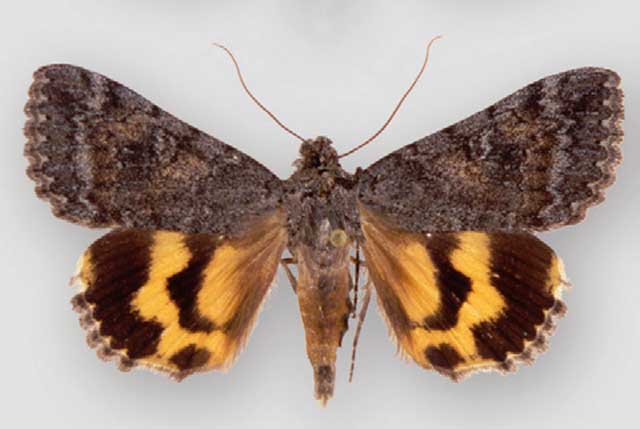
Catocala chelidonia occidentalis, Pinyon Flat, Santa Roas Mtns, Riverside County, California,
Holotype male, June 15, 1987, courtesy of David Hawks.
This site has been created by
Bill Oehlke.
Comments, suggestions and/or additional information are welcomed by Bill.
| TAXONOMY:
Superfamily: Noctuoidea
Family: Erebidae, Leach, [1815]
Subfamily: Erebinae, Leach, [1815]
Tribe: Catocalini, Boisduval, [1828]
Genus: Catocala, Schrank, 1802
|
DISTRIBUTION:
Catocala chelidonia occidentalis (forewing length: males: 20mm; females: 21 mm)
flies exclusively in California:
Riverside County: Santa Rosa Mountains, Pinyon Flat;
Kern County: 10 km NW of Frazier Park;
Los Angeles County: San Gabriel Mountains, 4 km SSW of Valyermo; Juniper Hills, 3 km S of Pearblossom; San
Gabriel Mountains, Ridge Route, Halfway House;
San Diego County: 6 km S of Oak Grove;
Lake County;
Madera County;
Napa County;
San Bernardino County;
Santa Clara County;
Solano County; and
Trinity County.
The forewings of C. c. occidentalis are similar to those of other C. chelidonia subspecies.
The forewing dorsal surface ground color is charcoal to brownish gray,
mottled with hoary scales. The antemedial and postmedial lines are black, and only modestly apparent.
The subreniform spot is whitish to yellow, and is usually visible.
Distinguishing hindwing characters include a dorsal surface with many black scales/hairs in the basal area
especially along the inner margin. C. c. occidentalis has a wider inner band, a narrower postmedial band,
and a consistently darker yellowish color.
About five percent of the specimens of C. c. occidentalis examined
could be confused with specimens of the nominate subspecies. David Hawks
The hindwing has pale areas of dull yellow orange.
The bands are black; the apical spot is dull yellow orange; the anal spot is separated from outer band.
There is a conspicuously
narrow yellow postmedial band (usually only 1–2 mm near vein M2). The anterior half
of the black outer band wide has a conspicuous rounded indentation in the inner edge
between M2 and Cu1. David Hawks
FLIGHT TIMES AND PREFERRED FOOD PLANTS:
Catocala chelidonia occidentalis larvae feed on Quercus cornelius-mulleri.
Adult moths are on the wing from early June to late August, with the
peak flight period in late June at Pinyon Flat.
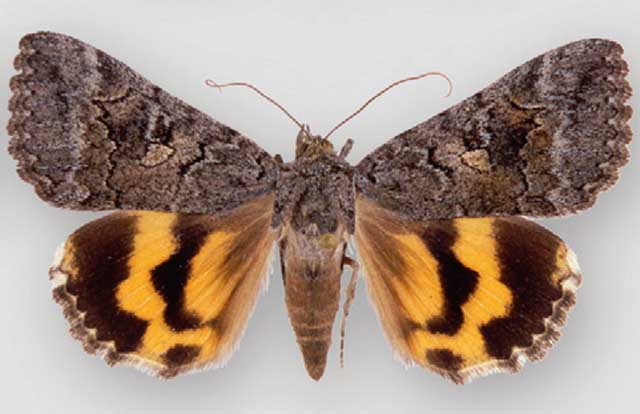
Catocala chelidonia occidentalis, Pinyon Flat, Santa Roas Mtns, Riverside County, California,
Allotype female, June 22, 1987, courtesy of David Hawks.
ECLOSION:
Adults eclose from pupae at soil surface.
SCENTING AND MATING:Catocala chelidonia occidentalis females
emit an airbourne pheromone and males use their antennae to track the
scent plume. Right: Catocala chelidonia occidentalis or C. mcdunnoughi male, Frazier Mountain
Rd, 5750', Ventura County, CA., September 7, 1991. Kelly Richers,
collector, at uv light.
| 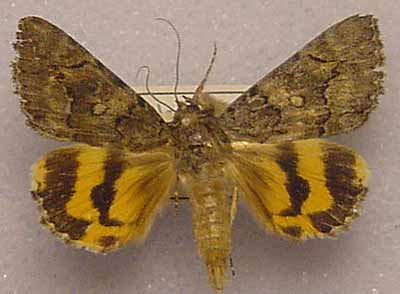 |
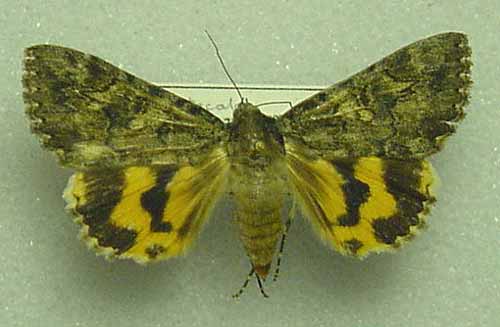
Catocala chelidonia occidentalis or C. mcdunnoughi female, two miles south
of Fishcamp, 4700'.
Madera County, CA..
Kelly Richers, collector, at uv trap.
The specimens sent to me by Kelly Richers were originally designated as Catocala chelidonia and they
may be subspecies C. c. occidentalis which is known from California. However, due to strong presence of am line as
well as distinct and lighter subreniform spot, I think they are more likely Catocala mcdunnoughi.
I note also the two elongated upper teeth in the pm line. They seem even more produced than in the specimens of
C. chelidonia occidentalis I have
pictured courtesy of David Hawks.
The late flight season (September) and high elevation (5750 feet) for the male also suggest C. mcdunnoughi.
In their recent (2010) publication, Gall and Hawks do not list either C. c. occidentalis or C. mcdunnoughi from
Ventura County. They do site C. c occidentalis from Madera County, but C. mcdunnoughi is not listed
there.
EGGS, CATERPILLARS, COCOONS AND PUPAE:
Eggs are deposited
on tree bark in the fall and hatch the following spring.
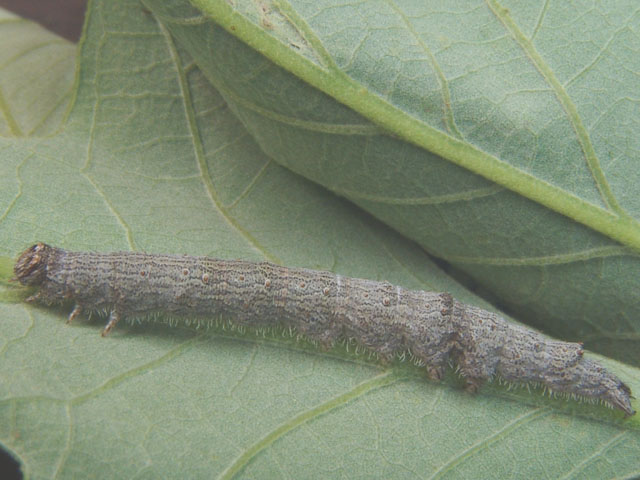
Catocala chelidonia subspecies ??, third instar, courtesy of Gabriel Larrabee.
copyright
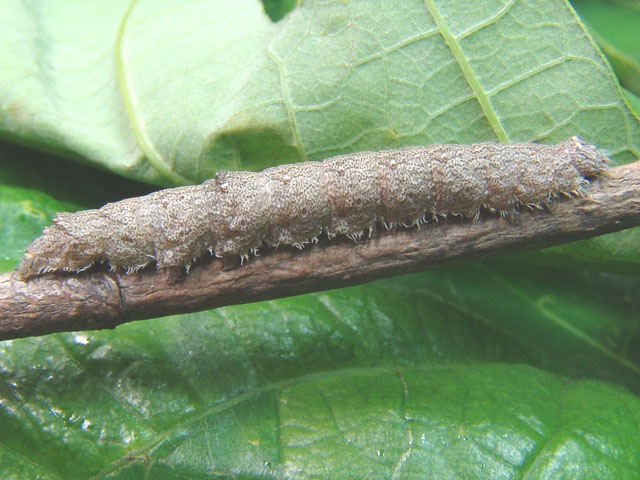
Catocala chelidonia subspecies ??, fifth instar, courtesy of Gabriel Larrabee.
copyright
Larval Food Plants
Listed below are primary food plant(s) and alternate food plants.
It is hoped that this alphabetical listing followed by the common
name of the foodplant will prove useful. The list is not exhaustive,
although some species seem very host specific.
Experimenting with closely related foodplants is worthwhile.
Quercus cornelius-mulleri ......
|
Muller oak/Desert scrub oak
|
Return to Main Index
This page is brought to you by Bill Oehlke and the
WLSS. Pages are on space rented from Bizland. If you would like to become a "Patron of the Sphingidae/Catocala Sites", contact Bill.
Please send sightings/images to Bill. I will do my best to respond to requests for identification help.
Enjoy one of nature's wonderments: Live Saturniidae (Giant Silkmoth) cocoons.

|

To show appreciation for this site, click on the flashing
butterfly to the left, a link
to many worldwide insect sites. |
Visit California Catocala
immatures
Visit Catocala delilah Species Complex; Author: David Hawks.







